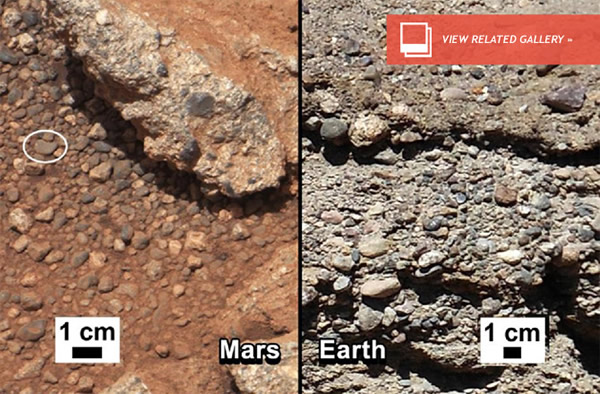Life's a Beach: Rover Finds Mars Pebbles
Life's a Beach: Rover Finds Mars Pebbles
When Curiosity was coasting through interplanetary space on its way to Mars, I doubt it considered the possibility that the landing site inside Gale Crater would be a pebbly beach — almost.
Although “beach” is a little generous, NASA scientists revealed on Thursday that the nuclear-powered rover had imaged pebbles that were shaped by water embedded in rock at “Bradbury Landing” — Curiosity’s landing site. Pebbles as small as grains of sand up to the size of golf balls were photographed inside conglomerate rock, a sign that they were shaped in a riverbed.
“We completed more rigorous quantification of the outcrops to characterize the size distribution and roundness of the pebbles and sand that make up these conglomerates,” said Rebecca Williams of the Planetary Science Institute, Tucson, Ariz. “We ended up with a calculation in the same range as our initial estimate last fall. At a minimum, the stream was flowing at a speed equivalent to a walking pace — a meter, or three feet, per second — and it was ankle-deep to hip-deep.”
The research, to be published in the journal Science this week, supports evidence gathered by Curiosity last year that indicated Curiosity’s area of study was once covered in flowing water.
This new finding is especially satisfying as Mars pebbles bear a striking resemblance to their terrestrial counterparts (see the comparison, top).
“These conglomerates look amazingly like streambed deposits on Earth,” Williams added in a NASA news release. “Most people are familiar with rounded river pebbles. Maybe you’ve picked up a smoothed, round rock to skip across the water. Seeing something so familiar on another world is exciting and also gratifying.”
Through analysis of the distribution of the pebbles of various sizes inside the conglomerates, Williams’ team was also able to deduce that the pebbles formed in a river or stream with persistent, steady flow that likely carried the material over long distances before depositing it downstream.
“Our analysis of the amount of rounding of the pebbles provided further information,” said co-author Sanjeev Gupta of Imperial College, London. “The rounding indicates sustained flow. It occurs as pebbles hit each other multiple times. This wasn’t a one-off flow. It was sustained, certainly more than weeks or months, though we can’t say exactly how long.”
The growing body of evidence supporting the idea that Mars used to be a much wetter world than today is compelling and this latest finding of a very familiar feature of long-term liquid water flow will help scientists understand just how extensive Mars’ hydrological cycle was in the planet’s ancient past.
So the next question that needs to be answered is: Did Mars’ surface water contribute to, and support, basic lifeforms? Although Curiosity cannot directly search for life, as it continues the long trek to Mt. Sharp in the middle of Gale Crater, further evidence of the Red Planet’s past and, possibly, present habitability may be revealed.(May 31, 2013 02:23 AM ET // by Ian O'Neill)












